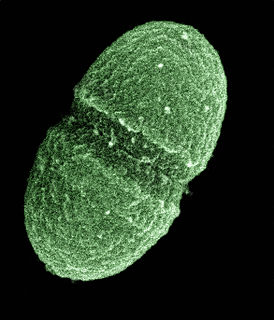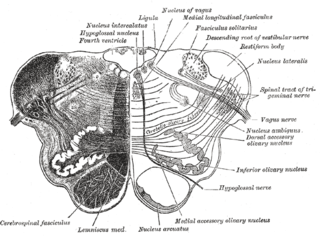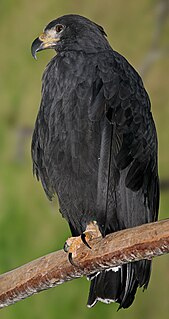
The blue rock thrush is a species of chat. This thrush-like Old World flycatcher was formerly placed in the family Turdidae. It breeds in southern Europe, northwest Africa, and from central Asia to northern China and Malaysia. The blue rock thrush is the official national bird of Malta and was shown on the Lm 1 coins that were part of the country's former currency.
Turdus Solitarius was a constellation created by French astronomer Pierre Charles Le Monnier in 1776 from stars of Hydra's tail. It was named after the Rodrigues solitaire, an extinct flightless bird that was endemic to the island of Rodrigues East of Madagascar in the Indian Ocean. It was replaced by another constellation, Noctua, in A Celestial Atlas (1822) by the British amateur astronomer Alexander Jamieson. Neither constellation is in current use.

Vancomycin-resistant Enterococcus, or vancomycin-resistant enterococci (VRE), are bacterial strains of the genus Enterococcus that are resistant to the antibiotic vancomycin.

Enterococcus faecalis – formerly classified as part of the group D Streptococcus system – is a Gram-positive, commensal bacterium inhabiting the gastrointestinal tracts of humans and other mammals. Like other species in the genus Enterococcus, E. faecalis is found in healthy humans, but can cause life-threatening infections, especially in the nosocomial (hospital) environment, where the naturally high levels of antibiotic resistance found in E. faecalis contribute to its pathogenicity. E. faecalis has been frequently found in reinfected, root canal-treated teeth in prevalence values ranging from 30% to 90% of the cases. Re-infected root canal-treated teeth are about nine times more likely to harbor E. faecalis than cases of primary infections.

Lactic acid bacteria (LAB) are an order of gram-positive, low-GC, acid-tolerant, generally nonsporulating, nonrespiring, either rod-shaped (bacilli) or spherical (cocci) bacteria that share common metabolic and physiological characteristics. These bacteria, usually found in decomposing plants and milk products, produce lactic acid as the major metabolic end product of carbohydrate fermentation. This trait has, throughout history, linked LAB with food fermentations, as acidification inhibits the growth of spoilage agents. Proteinaceous bacteriocins are produced by several LAB strains and provide an additional hurdle for spoilage and pathogenic microorganisms. Furthermore, lactic acid and other metabolic products contribute to the organoleptic and textural profile of a food item. The industrial importance of the LAB is further evidenced by their generally recognized as safe (GRAS) status, due to their ubiquitous appearance in food and their contribution to the healthy microflora of human mucosal surfaces. The genera that comprise the LAB are at its core Lactobacillus, Leuconostoc, Pediococcus, Lactococcus, and Streptococcus, as well as the more peripheral Aerococcus, Carnobacterium, Enterococcus, Oenococcus, Sporolactobacillus, Tetragenococcus, Vagococcus, and Weissella; these belong to the order Lactobacillales.

The Enterococcaceae are a family of Gram-positive bacteria placed in the order Lactobacillales. Representative genera include Enterococcus, Melissococcus, Pilibacter, Tetragenococcus, and Vagococcus. In this family are some important lactic acid bacteria which produce lactic acid as the major metabolic end product.

The solitary tract is a compact fiber bundle that extends longitudinally through the posterolateral region of the medulla. The solitary tract is surrounded by the nucleus of the solitary tract, and descends to the upper cervical segments of the spinal cord. It was first named by Theodor Meynert in 1872.

Bile Esculin Agar (BEA) is a selective differential agar used to isolate and identify members of the genus Enterococcus, formerly part of the "group D streptococci".

The solitary eagle or montane solitary eagle is a large Neotropical eagle. It is also known as the black solitary eagle.
Enterococcus faecium is a Gram-positive, alpha-hemolytic or non-hemolytic bacterium in the genus Enterococcus. It can be commensal in the gastrointestinal tract of humans and animals, but it may also be pathogenic, causing diseases such as neonatal meningitis or endocarditis.
Enterococcus durans is a species of Enterococcus. It is a Gram-positive, catalase- and oxidase-negative, coccus bacterium. The organism is also a facultative anaerobe. Prior to 1984, it was known as Streptococcus durans.
Tetragenococcus halophilus is a halophilic lactic acid bacterium active in the fermentation processes of soy sauce, miso, fish sauce and salted anchovies.
Enterococcus hirae is a species of Enterococcus. Its type strain is NCDO 1258. It is involved in growth depression in young chickens and endocarditis and septicemia in humans.
Tetragenococcus muriaticus is a species of moderately halophilic lactic acid, histamine-producing bacteria. X-1 is the type strain of this species.
Enterococcus mundtii is a species of Enterococcus. Its genome has been sequenced. The type strain is NCDO 2375.
Enterococcus raffinosus is a species of Enterococcus.
Enterococcus pseudoavium is a species of Enterococcus.
Tetragenococcus is a Gram-positive, facultatively aerobic, moderately halophilic and nonmotile bacterial genus from the family of Enterococcaceae.







